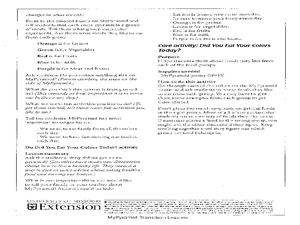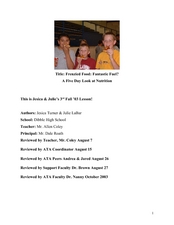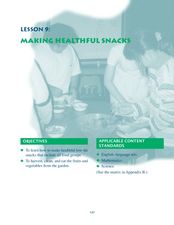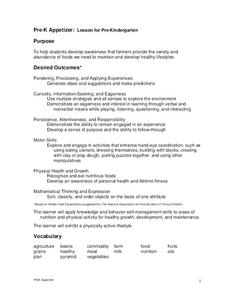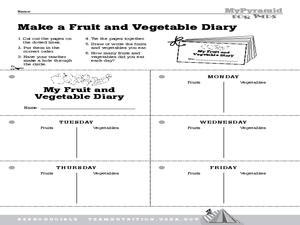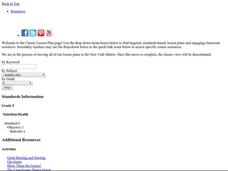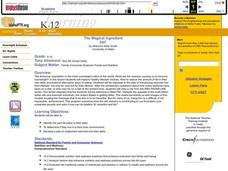Curated OER
Nutrition: Gregory the Terrible Eater
Students listen to a story about a goat who craves human food. They discover the four basic food groups and discuss what they might eat if they were terrible eaters. Students retell the story by looking at the pictures. They complete...
Curated OER
Introducing My Pyramid
Students explore MyPyramid. In this nutrition lesson, students compare and contrast MyPyramid, the new food guide from the U.S. Department of Agriculture, with the Food Guide Pyramid. Students discuss the importance of...
Curated OER
Spill Your Guts
Students practice nutrition facts. In this health and nutrition lesson, students participate in a game in which two teams compete to "spill their guts" by quickly answering factual questions pertaining to nutrition. This lesson is...
Curated OER
Nutrition in Me!
Third graders explain the basic healthy eating and physical activity concepts. In this healthy lifestyles activity, 3rd graders describe two main components of a healthy lifestyle, demonstrate two different types of physical...
Curated OER
Frenzied Food: Fantastic Fuel?
Students infer the causes of obesity. In this health science lesson, students brainstorm ways improve to their diet. They write personalized journals with goals on how to live a healthy lifestyle.
Curated OER
Revised “Understanding Nutrition” Activity
Students evaluate their current food choices. In this health science lesson, students test different drinks to rate the amount of Vitamin C content. They discuss results in class.
Curated OER
Does Your Diet Stack Up?
Third graders explore nutritional variety. In this nutritional variety lesson, 3rd graders explore the many options for a healthy and well balanced diet. Students explore the food pyramid with nutritional guidelines from other countries.
Curated OER
Making Healthful Snacks
Learners examine how to make healthy snacks that include all the food groups and how to harvest, clean and eat fruits and veggies from the garden. In this healthy snack lesson students complete several activities that have to do...
Curated OER
The Nutritional Content of Food
Students are given three unknown samples and must perform two chemical tests in order to determine if the samples contains protein and/or starch. Students work with corrosive or toxic reagents.
Curated OER
Don't Forget the Bacon
Young scholars choose healthy food from different food groups. In this health lesson, students classify pictures of food into each food groups and discuss which ones are healthy. They review the food pyramid and read the story Don't...
Curated OER
Build a Burger
Second graders describe a balanced diet. In this nutrition and health lesson, 2nd graders use a hamburger to exemplify the different food groups necessary for a blanaced diet. Students use the food pyramid as a resource.
Curated OER
Pre-K Appetizer
Students understand there are healthy and not healthy food choices. In this food pyramid lesson, students learn to make healthy choices by playing a traffic light game. Students recognize raw foods from the farm may not be ready for...
Curated OER
Lesson 3: Vary Your Veggies and Focus on Fruits
Students explore fruits and vegetables. In this nutrition instructional activity, students generate a list of all known fruits and vegetables. Students cut out and compile pages for a weekly fruits and vegetable...
Curated OER
Hand Washing: I Can Handle It!
Fifth graders examine virus transmission. In this health and nutrition lesson, 5th graders explore hand washing and food handling techniques that prevent food borne illnesses. Students name viruses and the diseases caused by them
Curated OER
The Secret Life of a French Fry
Students explore where the food they eat comes from. In this food activity, students look at agriculture and food production. They follow the production of a french fry and discuss all the steps it goes through before being served.
Curated OER
Calorie Countdown
Fifth graders analyze their caloric intake and energy output. In this nutrition and health instructional activity, 5th graders use the Dietary Guidelines for Americans to evaluate their personal food intake and activity level. Students...
Curated OER
Farm Products Help Me Grow
Students view a display of empty food containers (or illustrations). They select a food and decide as a class if it has an animal or plant origin. Students view a display of common farm animals that are commonly eaten (cow, pig, chicken,...
Curated OER
Agriculture Scavenger Hunt
In this science worksheet, students find the words that are related to the finding of terms and information about agriculture for ten questions. The answers are on page 3.
Curated OER
Climbing the Pyramid
Students examine the Food Pyramid to discover the foods they need to eat to have a healthy body. Using food brought to class, they must place the food in the correct category in the pyramid. In groups, they test food samples for fat...
Curated OER
MyPyramid for Kids
Students explore healthy food choices. In this science lesson, students identify food groups and discuss the amount of food they should eat from each group. Students create PyramindPal cartoons.
Curated OER
Peanut Butter Broccoli
Fifth graders explore food production by viewing DNA presentations. In this genetic engineering lesson, 5th graders discuss the foods they typically eat at home and how many common foods are engineered in a way that can produce a bigger...
Curated OER
Pre-K Appetizer
Students explore health by identifying positive eating habits. In this dietary lesson, students read several books about eating well and making wise food decisions. Students view the food pyramid on the USDA website and discuss the...
Curated OER
The Magical Ingredient: Fat
Students explore fats in foods. For this personal health and nutrition lesson, students view a Frontline video segment, examine the role fat plays in their personal diets, and develop plans to eliminate fats and implement exercise into...
Curated OER
The Magical Ingredient: FAT
Learners examine how the diet industry is contributing to our frustration over unwanted pounds. They identify the part fat plays in their diets and determine if they live in a food toxic environment.

